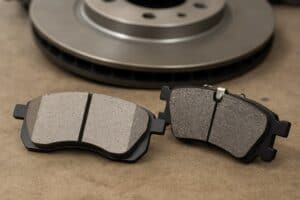Your brakes are one of the most important safety features on your car. Choosing the right type of brake pads can impact both performance and maintenance costs. As a Nashville car accident attorney might advise, understanding your options can help prevent accidents and ensure smoother driving.
What Are Brake Pads And Why Do They Matter?
Brake pads are key components in your car’s braking system. They create the friction needed to slow down or stop your vehicle when you press the brake pedal. Without reliable pads, stopping becomes unpredictable and unsafe.
There are different types of brake pads, but ceramic and semi-metallic are the most common. Each offers unique benefits and drawbacks depending on your driving style and environment. Picking the right one means better braking and longer part life.
Understanding the differences helps you make informed decisions when it’s time for maintenance. Whether you’re a daily commuter or weekend traveler, your brake pad choice matters. Let’s break down the pros and cons of each.
What Are Ceramic Brake Pads?
Ceramic brake pads are made from a dense ceramic material, often combined with fine copper fibers. These pads are known for producing less dust and offering quieter operation. They’re a popular choice for daily drivers who value comfort and clean wheels.
Ceramic pads perform well under regular driving conditions. They handle heat efficiently and provide smooth braking with minimal noise. This makes them ideal for city driving or commuting.
However, ceramic pads can be more expensive. They also may not perform as well in extreme cold or during aggressive braking. For most everyday drivers, though, they strike a good balance of performance and longevity.
What Are Semi-Metallic Brake Pads?
Semi-metallic brake pads are made from a mix of metals—such as iron, copper, and steel—blended with friction materials. These pads are typically more durable and better suited for high-performance or heavy-duty vehicles. They’re designed to withstand intense heat and hard braking.
These pads provide strong braking power, particularly in extreme conditions. That makes them a common choice for trucks, performance cars, and towing vehicles. If you drive in mountainous areas or carry heavy loads, they’re worth considering.
On the downside, semi-metallic pads tend to be noisier. They also produce more brake dust, which can cause your wheels to become dirty more quickly. While cheaper than ceramic in many cases, they may wear down rotors faster due to their abrasiveness.
Performance Differences On The Road
When it comes to stopping power, semi-metallic pads generally provide better performance. They grab harder, making them effective in emergencies. That’s why they’re often used in performance cars or vehicles carrying extra weight.
Ceramic pads provide smoother and more consistent performance under normal driving conditions. They might not match the raw power of semi-metallics, but they work well for everyday use. If you’re not pushing your car to the limit, ceramics are more than enough.
Also, consider how heat affects your brakes. Semi-metallic pads manage heat better under heavy loads. Ceramic pads also handle heat, but not as efficiently when subjected to prolonged stress.
Maintenance And Longevity
Ceramic brake pads usually last longer under typical driving conditions. They’re gentler on brake rotors and create less dust, which means cleaner wheels and fewer maintenance visits. Over time, their higher price can be offset by fewer replacements.
Semi-metallic pads may wear out quickly, depending on the level of driving aggression. They can also wear down rotors faster, potentially increasing repair costs. Still, they’re often cheaper to buy and install upfront.
Think about your priorities—lower maintenance or lower cost? Your choice should reflect how you drive and what kind of wear your vehicle sees day to day.
Which Type Is Right For You?
If you do a lot of city driving, stop-and-go commuting, or prefer quieter braking, ceramic pads are a great fit. They provide solid performance with fewer side effects, such as noise or dust. Plus, they usually last longer with less stress on your rotors.
If you drive a truck, tow heavy loads, or live in a hilly area, semi-metallic pads might be the better choice. Their superior braking power under stress gives you peace of mind. You may need to clean your wheels more often, but the stopping performance is worth it.
There’s no one-size-fits-all answer. Your vehicle type, driving habits, and budget all play a role in the right choice. If you’re unsure, a trusted mechanic can help you determine the best option based on your specific needs.
Final Thoughts
Brake pads may seem like a small detail, but they make a big difference in your safety. Whether you choose ceramic or semi-metallic, understanding the pros and cons will help you make smarter decisions. As a Nashville car accident attorney would confirm, reliable brakes are your first line of defense on the road.





